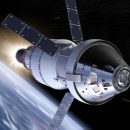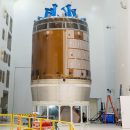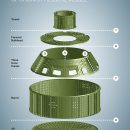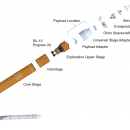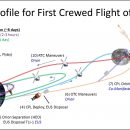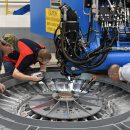When astronauts are on their first test flight aboard NASA’s Orion spacecraft, which will take them farther into the solar system than humanity has ever traveled before, their mission will be to confirm all of the spacecraft’s systems operate as designed in the actual environment of deep space. After an Orion test campaign that includes ground tests, systems demonstrations on the International Space Station, and uncrewed space test flights, this first crewed test flight will mark a significant step forward on NASA’s Journey to Mars.
This will be NASA’s first mission with crew in a series of missions in the proving ground, an area of space around the moon where crew can build and test systems needed to prepare for the challenge of missions to Mars. The mission will launch from NASA’s Kennedy Space Center in Florida as early as August 2021. Crew size will be determined closer to launch, but NASA plans to fly up to four astronauts in Orion for each human mission.
“Like every test flight, we will have test objectives for this mission both before and after we commit to going to the moon,” said Bill Hill, deputy associated administrator, Exploration Systems Development, NASA Headquarters in Washington. “It’s just like the Mercury, Gemini, and Apollo programs, which built up and demonstrated their capabilities over a series of missions. During this mission, we have a number of tests designed to demonstrate critical functions, including mission planning, system performance, crew interfaces, and navigation and guidance in deep space.”
Leaving Earth
The mission plan for the flight is built around a profile called a multi-translunar injection (MTLI), or multiple departure burns, and includes a free return trajectory from the moon. Basically, the spacecraft will circle our planet twice while periodically firing its engines to build up enough speed to push it toward the moon before looping back to Earth.
After launch, the spacecraft and upper stage of the rocket will first orbit Earth twice to ensure its systems are working normally. Orion will reach a circular orbit at an altitude of 100 nautical miles and last 90 minutes. The move or burn to get the spacecraft into a specific orbit around a planet or other body in space is called orbital insertion.
Following the first orbit, the rocket’s powerful exploration upper stage (EUS) and four RL-10 engines will perform an orbital raise, which will place Orion into a highly elliptical orbit around our planet. This is called the partial translunar injection. This second, larger orbit will take approximately 24 hours with Orion flying in an ellipse between 500 and 19,000 nautical miles above Earth. For perspective, the International Space Station orbits Earth from about 250 miles above.
Once the integrated vehicle completes these two orbits, the EUS will separate from Orion and any payloads selected and mounted inside the rocket’s universal stage adapter will be released. The payloads will then fly on their own to conduct their unique missions.
After the EUS separation, the crew will do a unique test of Orion’s critical systems. They will gather and evaluate engineering data from their day-long orbit before using Orion’s service module to complete a second and final propulsion move called the translunar injection (TLI) burn. This second burn will put Orion on a path toward the moon, and will conclude the “multi-translunar injection” portion of the mission.
“Free” ride home
The TLI will send crew around the backside of the moon where they will ultimately create a figure eight before Orion returns to Earth. Instead of requiring propulsion on the return, the spacecraft will use the moon’s gravitational pull like a slingshot to bring Orion home, which is the free return portion of the trajectory. Crew will fly thousands of miles beyond the moon, which is an average of 230,000 miles beyond the Earth.
A flexible mission length will allow NASA to gather valuable imagery data during daylight for the launch, landing and recovery phases. It will take a minimum of eight days to complete the mission, and pending additional analysis, it may be extended up to 21 days to complete additional flight test objectives.

Two missions, two different trajectories
The agency is scheduled to test SLS and Orion together for the first time without crew over the course of about three weeks in late 2018. The MTLI will build upon testing that will be done in a distant lunar retrograde orbit, or DRO, for that first mission. The DRO will put Orion in a more challenging trajectory, and will be an opportunity to test the kind of maneuvers and environments the spacecraft will see on future exploration missions. The DRO will require additional propulsion moves throughout the trip, including a moon flyby and return trajectory burns.
“Between the DRO on our first flight, and the MTLI on the second flight, we will demonstrate the full range of capabilities SLS and Orion need to operate in deep space,” said Hill.
Once these first two test flights are completed, Hill added that NASA hopes to begin launching missions every year with crew, depending on budget and program performance.
NASA recently outlined its exploration objectives in deep space and grouped them into three categories: transportation, working in space, and staying healthy. The early missions in the proving ground are a critical step on the journey to learn more about the deep space environment and test the technologies the agency needs to eventually take humans to Mars.
At the NASA Michoud Assembly Facility in Louisiana, Lockheed Martin technicians have started building the first Orion that will carry humans to deep space on Exploration Mission-2. Image courtesy of NASA.
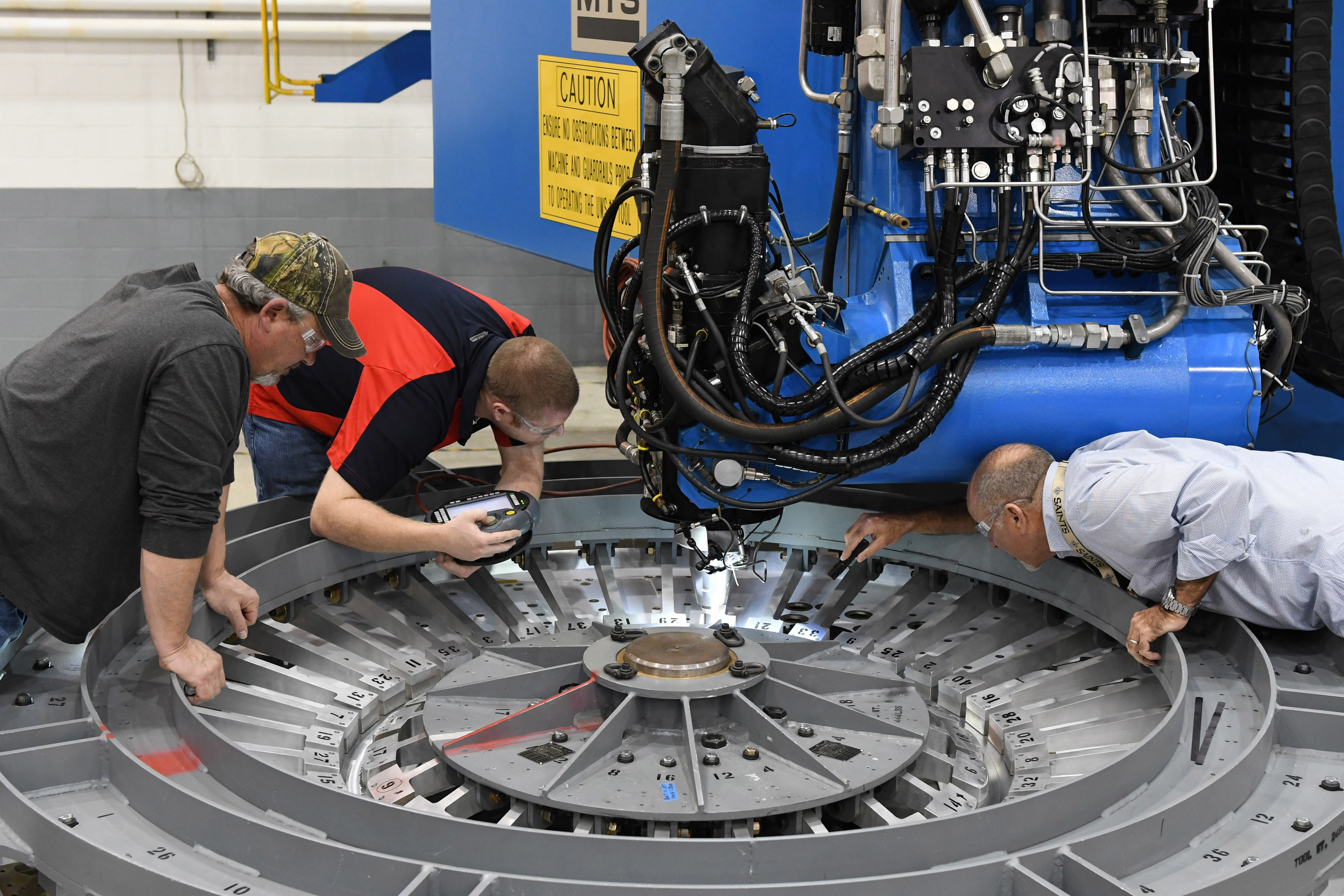
Soon Humans Will Travel Out Beyond the Moon
Lockheed Martin Begins Construction on First Orion Spaceship that will take Astronauts into Deep Space
Construction has officially begun on the spaceship that will achieve America’s goal of returning astronauts to the Moon. Lockheed Martin (NYSE: LMT) technicians and engineers at the NASA Michoud Assembly Facility near New Orleans welded together the first two components of the Orion crew module capsule for Exploration Mission-2 (EM-2).
Orion is America’s exploration spaceship, and the EM-2 mission will be its first flight with astronauts on board, taking them farther into the solar system than ever before. This flight, launched atop the Space Launch System (SLS) rocket, will usher in a new era of space exploration, laying the groundwork for NASA’s lunar Deep Space Gateway, and ultimately for human missions to Mars.
“Orion has tremendous momentum. We’re finishing assembly of the EM-1 Orion spacecraft in Florida, and simultaneously starting production on the first one that will carry crew,” said Mike Hawes, Lockheed Martin vice president and program manager for Orion. “This is not only the most advanced spacecraft ever built, its production will be more efficient than any previous capsule. For example, look at the progress we’ve made on the EM-2 pressure vessel compared to the first one we built. The latest version is 30 percent lighter and has 80 percent fewer parts. That equates to a substantially more cost-effective and capable spacecraft.”
Designed specifically to withstand the harsh and demanding environment of deep space travel while keeping the crew safe and productive, the main structure of the crew module, or pressure vessel, is comprised of seven large machined aluminum alloy pieces that are welded together to produce a strong, yet light-weight, air-tight capsule. The first weld joined the forward bulkhead with the tunnel section to create the top of the spacecraft.
The pressure vessel capsule will continue to be built out over the spring and summer in Michoud incorporating the three cone panels, the large barrel and the aft bulkhead. Once completed in September, it will be shipped to the Kennedy Space Center where the Lockheed Martin team will perform assembly and test of the EM-2 spacecraft.
“The EM-1 and EM-2 crew modules are very similar in design, but we’ve made a lot of improvements since we built EM-1, including processes, scheduling, and supply chain, all contributing to a lower cost and faster manufacturing,” said Paul Anderson, director of Orion EM-2 production at Lockheed Martin.
But the historical importance of this Orion mission isn’t lost to Anderson and his team. “Each of these spacecraft are important, but we realize that the EM-2 capsule is special as it’s the first one to carry astronauts back out to the Moon, something we haven’t done in a long time. It’s something we think about every day.”

NASA Seeks Payload Concepts for Second SLS Test Flight
NASA’s Space Launch System (SLS), the world’s most powerful rocket, is designed to be flexible and evolvable to meet a variety of crew and cargo mission needs for deep-space missions. The agency is seeking potential scientific and technological payloads for the second integrated flight of SLS with NASA’s Orion spacecraft, known as Exploration Mission-2, or EM-2.
Featuring an enhanced rocket configuration for EM-2, SLS will include a new universal stage adapter, payload adapter and exploration upper stage. A request for information (RFI) released today seeks ideas from NASA, industry, academia and international partners for co-manifested payloads within the universal stage adaptor through Nov. 7, 2016.
EM-2 will be the first test flight for the rocket and spacecraft with crew, and is targeted to launch from Kennedy Space Center in Florida in 2021. The mission’s primary goals are to demonstrate Orion’s crew capabilities and the upgraded SLS rocket.
“This mission is another important step into the proving ground of deep space,” said Bill Hill, deputy associate administrator for Exploration Systems Development at NASA Headquarters in Washington. “EM-2, powered by the enhanced SLS, will be the first opportunity to carry large co-manifested payloads. We look forward to seeing what innovative ideas there are for using this unique capability to advance exploration, science, and technology goals in support of our Journey to Mars.”
For the purpose of this RFI, NASA is seeking ideas for one large payload up to 13,200 pounds (6,000 kilograms) or smaller, stackable payloads up to 661 pounds (300 kilograms) each. Payloads could be mounted in any number of configurations within the adapter, which sits between the Orion spacecraft and rocket’s upper stage. Actual mass allocations on the flight would depend on the flight trajectory and payload capacity after the primary mission is satisfied.
Current EM-2 mission concepts assumes that any co-manifested payloads would deploy from SLS and have no further interaction with the rocket or Orion spacecraft. NASA would provide the launch opportunity, and the payload provider would assume all payload costs.
The early missions of SLS and Orion will be the first of several missions that travel more than 40,000 miles beyond the moon to demonstrate capabilities in deep space farther than humans have ever traveled, but close enough to return home in days or weeks if needed. The first integrated mission, known as Exploration Mission-1, is targeted to launch in late 2018.
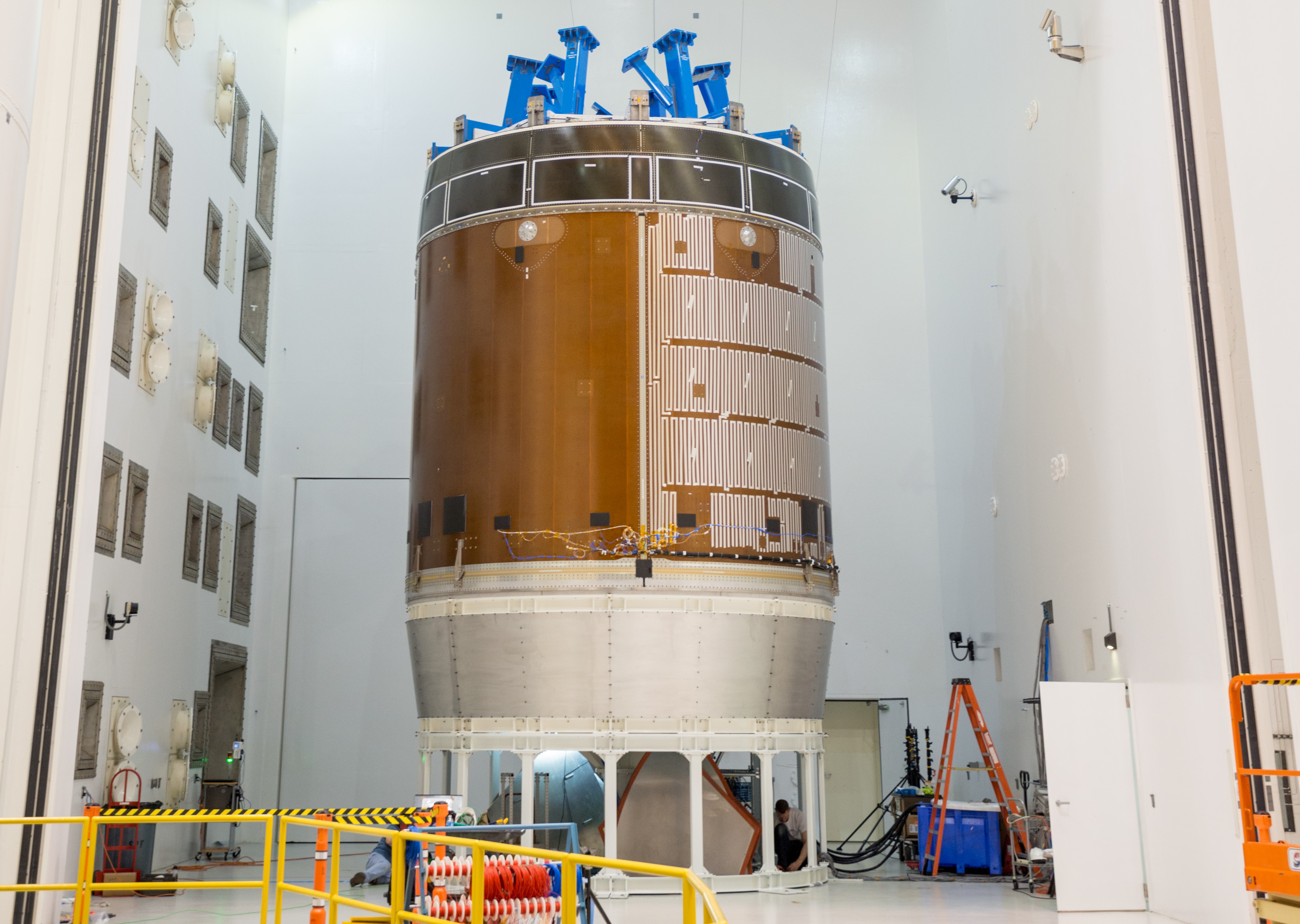
Orion’s Service Module Completes Critical Design Review
NASA and ESA (European Space Agency) conducted a critical design review (CDR) culminating in a final review board June 16 for Orion’s European-built service module. The service module is an essential part of the spacecraft that will power, propel, and cool Orion in deep space as well as provide air and water for crew members. The CDR rounds out the latest in a series of reviews for the three human exploration systems development programs that will enable the journey to Mars.
During the review process, technical experts examined the module designs and numerous items were processed and closed out, giving engineers confidence the module design is mature enough to continue with fabrication, assembly, integration and testing.
The recently completed review focused on the overall service module design while discussing differences between Orion’s first deep space mission atop the Space Launch System (SLS) rocket and the mission to follow that will carry crew. No new major issues were identified during the review, and the teams worked together to develop a plan for work going forward in areas such as power, solar array management and propellant usage.
“The teams at NASA and ESA worked together successfully over the past few weeks to bring design decisions and required products to the CDR board,” said William Gerstenmaier, associate administrator for NASA’s Human Exploration and Operations Mission Directorate. “International collaboration is an important part of the effort NASA is leading to pioneer deep space.”
The review was conducted at ESA’s European Space Research and Technology Centre in Noordwijk, Netherlands with teams from NASA, ESA, Lockheed Martin and Airbus Defence & Space in Bremen, Germany. Lockheed Martin is NASA’s main contractor building Orion, and Airbus is ESA’s contractor for the service module.
“This was a tremendous effort on the part of the team from both sides of the Atlantic,” said James Free, deputy associate administrator for NASA’s Human Exploration and Operations Mission Directorate, who participated in much of the CDR. “Anytime you do something for the first time you can run into challenges, but we have been working side-by-side with ESA and Airbus to make Orion integration go as smoothly and efficiently as possible.”
The CDR identified April 2017 as the target for the service module delivery to Kennedy Space Center in Florida. Teams will begin integrating hardware into the rocket before the service module is delivered, and NASA plans to continue to optimize processing when it arrives at Kennedy. Initial results maintain EM-1 launch date no later than November 2018.
“There is some design maturation work that will occur while the module is being manufactured,” added Free. “We will also continue to evaluate updates to the shipping plans for the service module to prioritize work and refine schedules, and we will identify the best options to integrate our overall schedule.”
Results of the service module’s review will be briefed to senior NASA and ESA officials in the coming weeks.
This milestone is the latest in a series of accomplishments critical for the agency’s deep space missions. NASA’s SLS was its first human-rated rocket in almost 40 years to complete and clear a CDR, which wrapped in October 2015. The world’s only human-rated deep space vehicle, Orion, and the Ground Systems Development and Operations Program that will provide the facilities and ground support at Kennedy to prepare SLS and Orion for the journey to Mars, completed a joint CDR in March 2016.

The Ins and Outs of NASA’s First Launch of SLS and Orion
NASA is hard at work building the Orion spacecraft, Space Launch System (SLS) rocket and the ground systems needed to send astronauts into deep space. The agency is developing the core capabilities needed to enable the journey to Mars.
Orion’s first flight atop the SLS will not have humans aboard, but it paves the way for future missions with astronauts. Ultimately, it will help NASA prepare for missions to the Red Planet. During this flight, currently designated Exploration Mission-1 (EM-1), the spacecraft will travel thousands of miles beyond the moon over the course of about a three-week mission.
It will launch on the most powerful rocket in the world and fly farther than any spacecraft built for humans has ever flown. Orion will stay in space longer than any ship for astronauts has done without docking to a space station and return home faster and hotter than ever before.
“This is a mission that truly will do what hasn’t been done and learn what isn’t known,” said Mike Sarafin, EM-1 mission manager at NASA Headquarters in Washington. “It will blaze a trail that people will follow on the next Orion flight, pushing the edges of the envelope to prepare for that mission.”
SLS and Orion will blast off from Launch Complex 39B at NASA’s modernized spaceport at Kennedy Space Center in Florida. The spacecraft will deploy its solar arrays and the SLS upper stage, called the Interim Cryogenic Propulsion Stage (ICPS). This will give Orion the big push needed to leave Earth’s orbit and travel toward the moon. From there, Orion will separate from the ICPS. The ICPS will then deploy a number of small satellites, known as CubeSats, to perform several experiments and technology demonstrations.
As Orion continues on its path from Earth orbit to the moon, it will be propelled by a service module provided by the European Space Agency, which will supply the spacecraft’s main propulsion system and power (as well as house air and water for astronauts on future missions). Orion will pass through the Van Allen radiation belts, fly past the Global Positioning System (GPS) satellite constellation and above communication satellites in Earth orbit. To talk with mission control in Houston, Orion will switch from NASA’s Tracking and Data Relay System satellites and, for the first time for a human spaceflight vehicle in decades, communicate through the Deep Space Network.
The outbound trip to the moon will take several days, during which time engineers will evaluate the spacecraft’s systems and, as needed, correct its trajectory. Orion will fly about 62 miles (100 km) above the surface of the moon, and then use the moon’s gravitational force to propel Orion into a new deep retrograde, or opposite, orbit about 40,000 miles (70,000 km) from the moon.
The spacecraft will stay in that orbit for approximately six days to collect data and allow mission controllers to assess the performance of the spacecraft. During this period, Orion will travel in a direction around the moon retrograde from the direction the moon travels around Earth.
For its return trip to Earth, Orion will do another close flyby that takes the spacecraft within about 60 miles of the moon’s surface, the spacecraft will use another precisely timed engine firing of the European-provided service module in conjunction with the moon’s gravity to accelerate back toward Earth. This maneuver will set the spacecraft on its trajectory back toward Earth to enter our planet’s atmosphere traveling at 25,000 mph (11 kilometers per second), producing temperatures of approximately 5,000 degrees Fahrenheit (2,760 degrees Celsius) – faster and hotter than Orion experienced during its 2014 flight test. The spacecraft will splashdown in the Pacific Ocean off the San Diego coast.
This first exploration mission will allow NASA to use the lunar vicinity as a proving ground to test technologies farther from Earth, and demonstrate it can get to a stable orbit in the area of space near the moon in order to support sending humans to deep space, including for the Asteroid Redirect Mission. NASA and its partners will use this proving ground to practice deep-space operations with decreasing reliance on the Earth and gaining the experience and systems necessary to make the journey to Mars a reality.
Into the Proving Ground: Objectives for Human Exploration Near the Moon
The early missions for NASA’s Deep Space Exploration Systems will set the cadence for many missions to follow. The Orion spacecraft, launched by the Space Launch System (SLS) rocket, will travel more than 40,000 miles beyond the moon to an area that is only about three to five days away from Earth, yet farther than the Apollo astronauts traveled. With flight hardware in production for the first mission, NASA has established integrated human exploration objectives combining the efforts aboard the International Space Station, SLS and Orion, and other capabilities needed to support human missions on the Journey to Mars.
“The area of space near the moon offers a true deep space environment to gain experience for the Mars system and transit there, but with the ability to return to Earth in days rather than weeks or months if needed,” said William Gerstenmaier, associate administrator for Human Exploration and Operations at NASA Headquarters in Washington. “This is the ideal proving ground for NASA and its partners to accomplish our exploration objectives.”
This volume of space extends from geostationary orbit around Earth to encompass the moon and orbits around it is known as cislunar space and is where we will be able to demonstrate, advance and validate the very capabilities we will need to send humans to Mars, added Gerstenmaier.
The journey to Mars crosses three thresholds, each with increasing challenges as humans move farther from Earth, starting with Earth reliant exploration aboard the space station in low-Earth orbit, through the proving ground of cislunar space, and culminating with Earth independent exploration where human missions to the Mars system are possible. The exploration objectives are grouped into three cross-cutting categories, transportation, working in space, and staying healthy, which will support human exploration in deep space throughout the three thresholds.
Work is already underway on an initial set of objectives in low-Earth orbit to mature many systems needed for deep space habitation and exploration. Proving ground missions will build on those accomplishments in two phases that will demonstrate our exploration systems and validate our exploration capabilities. These objectives will inform future flight test objectives and enable planners to begin building the detailed profiles and trajectories for the missions in the near-term through the end of the 2020s.
The period of exploration in the proving ground will begin with the first integrated launch of SLS and Orion, anticipated in 2018, and will extend through the 2020s. The first phase will focus on demonstrating the safe operation of the integrated SLS rocket and Orion spacecraft and other exploration operations to support short-duration objectives in cislunar space. NASA aims to begin a cadence of one flight per year after the second mission. This phase of proving ground missions will allow us to test technologies in their intended environment and apply innovative approaches to solving problems in preparation for longer duration missions in deep space.
Following the robotic portion of the Asteroid Redirect Mission that will retrieve an asteroid boulder and put it in an orbit near the moon, Orion will take crew to visit the boulder and collect samples in the mid-2020s. Completing the Asteroid Redirect Mission will mark the end of the first phase of deep space exploration in the proving ground and the agency will transition to the second phase that will allow NASA to validate its exploration capabilities.
The second phase will confirm that the agency’s capabilities can perform for long duration Mars class missions and will culminate at the end of the 2020s with a one year mission in cislunar space before venturing on crewed missions beyond the Earth-Moon system. This phase includes the validation of integrated SLS, Orion, habitation, crew, and in-space transportation systems to build confidence that human missions to Mars can be safely conducted with independence from Earth.
What we learn in the proving ground will pave the way for Earth independence by helping break our reliance on the logistics and supply chain, and reduce our dependence on ground control. This stage will enable explorers to identify and pioneer innovative solutions to technical and human challenges that could only have been discovered or engineered in deep space. The capabilities needed for operations in the Earth Independent period will depend on knowledge and experience that is expected to be gained in the previous two periods.
“These objectives are dynamic and NASA’s planning will continue to be informed by advances in technology and scientific knowledge, as well as by opportunities presented by growing commercial capabilities and international participation,” said Gerstenmaier. “Ultimately, the proving ground missions make possible our vision of humans living and working in deep space for years and returning safely home.”

Living in Deep Space: Lockheed Martin to Build Full-Scale Prototype of NASA Cislunar Habitat
Refurbishing a shuttle-era cargo container used to transfer cargo to the International Space Station, Lockheed Martin (NYSE: LMT) is prototyping a deep space habitat for NASA at Kennedy Space Center. This prototype will integrate evolving technologies to keep astronauts safe while onboard and operate the spacecraft autonomously when unoccupied.
Under a public-private partnership, NASA recently awarded Lockheed Martin a Phase II contract for the Next Space Technologies for Exploration Partnerships (NextSTEP) habitat study contract. As part of Phase II, the team will continue to refine the design concept developed in Phase I and work with NASA to identify key system requirements for the Deep Space Gateway. Included in this work, the team will build a full-scale habitat prototype in the Space Station Processing Facility at NASA’s Kennedy Space Center and a next-generation deep space avionics integration lab near Johnson Space Center.
“It is easy to take things for granted when you are living at home, but the recently selected astronauts will face unique challenges,” said Bill Pratt, Lockheed Martin NextSTEP program manager. “Something as simple as calling your family is completely different when you are outside of low Earth orbit. While building this habitat, we have to operate in a different mindset that’s more akin to long trips to Mars to ensure we keep them safe, healthy and productive.”
A full-scale prototype of the deep space habitat will be built by refurbishing the Donatello Multi-Purpose Logistics Module (MPLM). Donatello was one of three large modules, flown in the space shuttle payload bay, that were used to transfer cargo to the International Space Station. The team will also rely heavily on mixed reality prototyping using virtual and augmented reality. Through this approach, the team can reduce cost and schedule, as well as identify and solve issues early in the design phase.
“We are excited to work with NASA to repurpose a historic piece of flight hardware, originally designed for low Earth orbit exploration, to play a role in humanity’s push into deep space,” said Pratt. “Making use of existing capabilities will be a guiding philosophy for Lockheed Martin to minimize development time and meet NASA’s affordability goals.”
The work will occur over 18 months and will build upon the concept study performed in Phase I. Phase II will also focus on mixed reality and rapid prototyping, and working on concept refinement and risk reduction. The new results, which will be provided to NASA, will further the understanding of the systems, standards and common interfaces needed to make living in deep space possible.
The Deep Space Gateway will rely on many of Orion’s advanced capabilities that can be used while astronauts are there, and utilizes capabilities common to Lockheed Martin-built planetary spacecraft like Juno and MAVEN while it’s unoccupied. Employing NASA’s space-proven Orion spacecraft as the Deep Space Gateway command deck early on allows for a safe and practical approach for the incremental build-up of deep space exploration capabilities.
Additionally, Lockheed Martin will build a Deep Space Avionics Integration Laboratory in Houston to demonstrate command and control between the Deep Space Gateway and Orion. The lab will help reduce risk associated with critical data interfaces between Deep Space Gateway elements and provide an environment for astronauts to train for various mission scenarios.
“Because the Deep Space Gateway would be uninhabited for several months at a time, it has to be rugged, reliable and have the robotic capabilities to operate autonomously. Essentially it is a robotic spacecraft that is well-suited for humans when Orion is present,” said Pratt. “Lockheed Martin’s experience building autonomous planetary spacecraft plays a large role in making that possible.”

Links
NASA’s Journey to Mars
About NASA
The National Aeronautics and Space Administration is an independent agency of the executive branch of the United States federal government responsible for the civilian space program, as well as aeronautics and aerospace research. Founded in July 29, 1958 by Dwight D. Eisenhower. NASA has its Headquarters in Washington, D.C.
About Lockheed Martin
Headquartered in Bethesda, Maryland, Lockheed Martin is a global security and aerospace company that employs approximately 100,000 people worldwide and is principally engaged in the research, design, development, manufacture, integration and sustainment of advanced technology systems, products and services.

